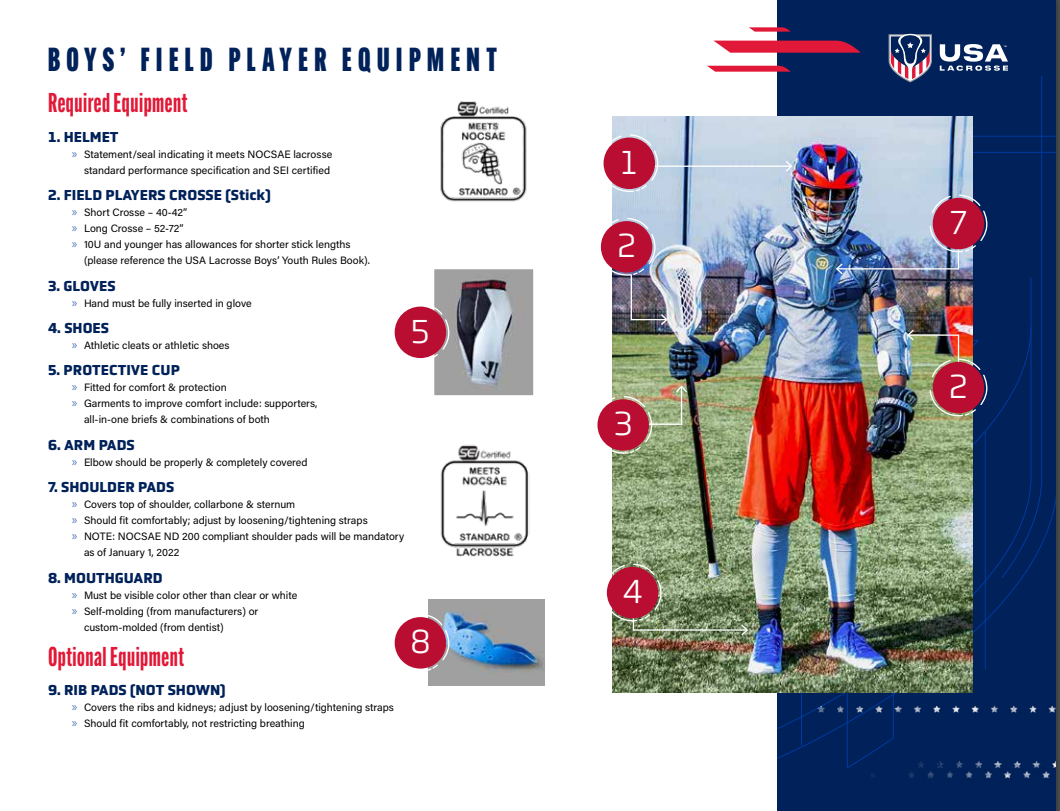Lacrosse Resources
Summer Camps
If you are looking for lacrosse camps this summer, here is a starting list of local ones to consider. Many of our boys have and will attend these camps! Did we miss any good ones? Let us know and we will it add to our list.
Back 2 Basics Lacrosse Camp – The All Sports Center, Collegeville PA
Be Your Best Lacrosse Camps – Wissahickon Middle School, Wissahickon PA
Black Bear – Multiple locations
NXT Play Fast – Cabrini University, Wayne PA
LaSalle Lacrosse Camp – LaSalle College High School, Wyndmoor PA
Club Lacrosse
What is it? Club lacrosse is for those players looking to compete at an elite level and is a supplemental option to township recreation ball. Club teams typically run tryouts in the summer, normally late June to end of July. While each club team has varying models, most travel for tournaments regionally (PA, NJ, DE, MD, VA, NY) for several weekends throughout the summer, typically attend a few tournaments in the fall as well as offer some options throughout the winter such as indoor box lacrosse.
What’s the time commitment? Many club teams respect township lacrosse scheduling, however, some do have practices and games in the spring. Make sure it works for your schedule.
What do we recommend? Do your research and tryout for a few! Each club team has its own unique vibe, make sure the culture of the team fits what you are looking for. Some local clubs are listed below. If you have any questions reach out.
• Black Bear Lacrosse
• Black Widow
• Colts
• Delco
• Duke's Elite
• Freedom
• HHH
• Mesa Lacrosse
• NXT
• Team Ten
• Team 11
• True Lacrosse
Equipment
Donation and Loaner Equipment
Do you have some old equipment that’s still usable? MBLC is looking for donations of sticks, helmets, gloves, and elbow pads to help build our loaner inventory. Message us via the contact page and indicate “Equipment Donation” in the subject line.
Lacrosse equipment can be expensive. If you need assistance in getting equipment for your son, please email us. MBLC is committed to helping equip any player looking to join our club.
Buying Guide
Stick:
A correctly sized lacrosse stick with a well strung pocket is essential to a child learning to play the game. Youth lacrosse players are allowed to cut the shaft to a minimum length of 26 inches. Once they add the head to the shaft, the combined length will be within the youth regulation size of 36” to 42” long. It’s a judgment call when deciding shaft length for young lacrosse players. Reach out to us if you aren’t sure.
Beginner Stick:
Two of the best first-time youth sticks (10 and under):
Warrior Evo WARP Jr.- The pocket is knitted on and is ready to throw right out of the box with a consistent release point every throw.
Warrior Evo Warp Jr.
StringKing Complete 2 Junior- A great starter stick for someone that wants their child to get used to a more traditional mesh pocket, which will most likely be the pocket they chose to play with as they get older. This stick also has a thinner shaft which is great for teaching your child cradling and ball control.
Stringking Complete 2 Jr
Less expensive sticks, like the STX Stallion and Under Armor Command Junior can be fine but have pockets that will require breaking. Refer to the guidance below on how to break in a stick and for tips on preventing bagging and whip.
Pocket:
One of the most common reasons kids struggle when throwing a lacrosse ball is the pocket. Most inexpensive beginner sticks are poorly strung and will result in your child struggling to throw, and or cradle. See our stick buying guide below for our recommendations.
A good pocket is one where your son can cradle and catch the ball. When they go to throw the ball, it should release towards the top of the stick so that they are not throwing into the ground when they pass.
Breaking in a Pocket:
The best way to break in a pocket is to play with it, if your son is a beginner this may prove challenging but there are still other ways of breaking it in. Start by taking a ball and pounding the pocket from both sides (front and back). Focus on the higher half of the stick around the shooting strings. A weighted lacrosse ball or a baseball bat standing upright makes this method go quickly.
Learn how to break in a pocket here:
If needed you can loosen the bottom lace so that the ball sits nicely in the bottom of the stick, but make sure it does not make the stick illegal (if you can see the top on the ball from the side of the stick)
A perfect pocket is when looking at the pocket sideways the top of the lacrosse ball is at the bottom rail of the stick. You can loosen the bottom lace on the stick to assist if needed.
How to Prevent Bagging & Whip in a Pocket:
If the pocket is getting too deep, tighten the bottom lace to prevent bagging. If the problem persists it may be time for a new pocket.
Whip is the term used to describe the ball staying in the pocket longer and releasing later. In youth lacrosse players this results in throwing/shooting into the ground. In professional lacrosse players this adds speed to their shots and hold to their cradling.
Some whip is ok, too much is impossible for a kid to play with. If you notice you son throwing/shooting the ball too low try one of the following:
- Tighten bottom lace, making the pocket more shallow
- Loosen shooting strings
- Remove the lowest shooting string
Protection Guide for Beginners
Shoulder Pads
STX Stallion, Maverik Charger, and Warrior Burn are 3 of the most common youth brands. NOTE: All shoulder pads must meet NOCSAE performance standard ND200 to help address commotio cordis.
Gloves & Elbow Pads
STX Stallion, Maverik Charger, and Warrior Burn are 3 of the most common youth brands.
Lacrosse Helmets
Cascade and Warrior are the most common brands, with STX Rival having youth specific helmet as well.
Helmet Tips:
- Do - Get a mouth guard that attaches to the facemask so it’s always available for your son to use.
- Do - Place the helmet onto the player and adjust it so he is looking through the first or top set of bars of the helmet.
- Do - Tighten the chinstrap and the back of the helmet so it fits snugly and evenly on the player.
- Do – Ensure the top chin straps (typically with the brands name on them) are attached to the top snap buttons of the helmet. Check they are even in how tight they fit.
- Do – Make sure the bottom straps are also even in length and snap onto the bottom or side snap buttons.
- Do - Always unbuckle the bottom or side snap buttons when taking off the helmet. Typically, once you have them set, you will never need to unbuckle the top straps.
- Don’t - Buy a helmet that is too big to “grow into”.
- Don’t – Look through the second or third set of bars.
- Don’t – Have uneven levels of chinstrap tightness.
USA Lacrosse Equipment Guide


